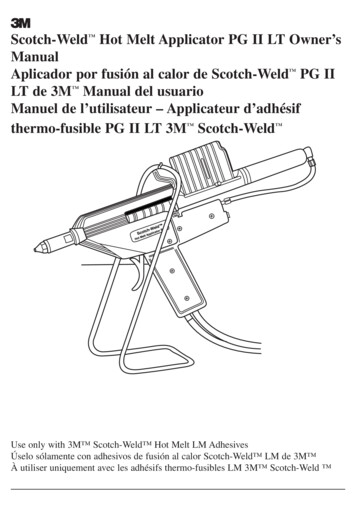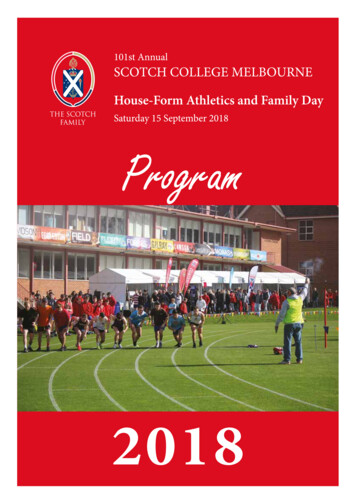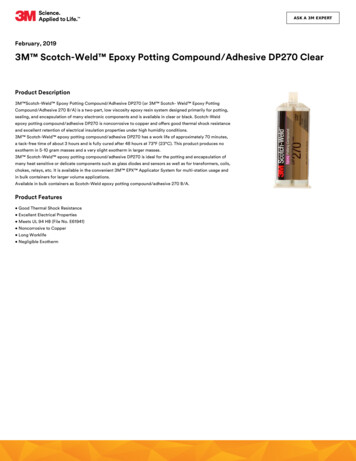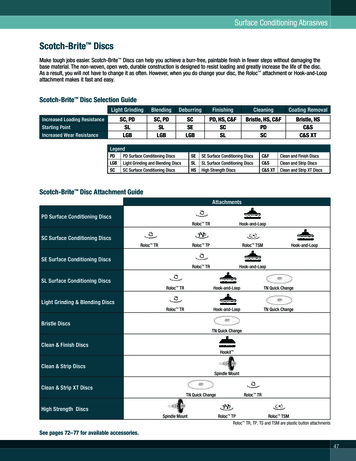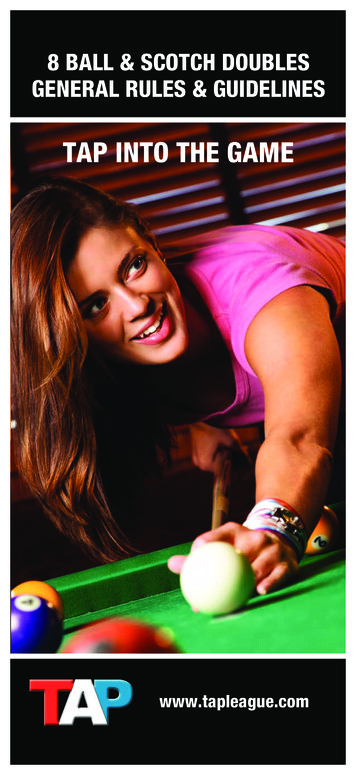
Transcription
8 BALL & SCOTCH DOUBLESGENERAL RULES & GUIDELINESTAP INTO THE GAMEwww.tapleague.com
A Message To All Members of TAP, LLCWe at TAP, LLC, also referred to as TAP, would like totake this opportunity to welcome you to the new generation ofleague play. Our goal is to promote the sport of billiards in a forumthat fosters fellowship, good sportsmanship and team spirit. Youraffiliation with TAP is very important to us – important because itlets us know that you share the same love for the sport of billiardsas we do. We hope that you enjoy your league play, and we arecertain that you’ll witness your skills developing as you participatein the fastest growing team sport of the new millennium.TAP has put a good deal of effort into developing theprograms offered to our members. Our research has noted thatthere are dozens of different ways to play the games of 8-Ball and9-Ball, and these vary from establishment to establishmentthroughout the world. We’ve structured our rules to be as fair aswe possibly can to all of our players, regardless of where they arecompeting. Please remember that there will be circumstances thatarise that are not specifically covered in the rules. We ask you touse this booklet as a guide, and let your common sense andsportsmanship do the rest. Also remember that there are all levelsof players and teams in TAP. Some like to play for fun, andothers enjoy the thrill of competition. Please remember that we allhave the right to play and participate. Whatever a person’s reasonfor playing, respect them and encourage others to do their best.TAP. and its subsidiary, POOL Net, are nationally andinternationally recognized league and tournament managementsystems. The support of our players and our products have elevatedus to where we are today, and your continued support will put us inthe forefront of the industry we’ve all grown to love. We hope tosee all of you at one of our major events, and perhaps some-day,we’ll be handing you a check for the winner’s share. Until then,kick back and enjoy your league experiences and remember “After all the rest,Why not the best?”Copyright – TAP, LLC 1-20151
Many of our members have been playing league pool for years;however, some find themselves participating in organizedleague play for the first time. If this is the case, a few simplerules will make your league experience, as well as those of yourteammates, as enjoyable as possible.The rules are as follows:1.Before being allowed to compete in a TAP event or league,you must be a bona fide member in good standing with TAPand willing to play under our General Rules listed in this book.For example, filling out a complete membership application,paying your annual membership dues, league fees andtournament fees, staying active for any events, sessions ortournaments you or your team may have entered or qualifiedfor. Remember the time to stop playing is when you havecompleted your obligations for the session and events for thatsession.2.When you sign up to play in a league, you make a commitment toyour league and teammates to play the entire league session.League pool is a team effort and only through this commitmentcan we foster the type of fellowship and sportsmanship that weare looking to develop through active participation in TAP. Alsotry your best to stay committed to the team you started with.Changing teams is sometimes needed but should be done early inthe session. Decisions regarding the ability of a player to switchfrom one team to another will be made at the discretion of theLeague Director in conjunction with their League Owner andcorporate office. Abuse of this privilege will not be tolerated.3.You should make it a point to be on time to play your leaguematches. It is a matter of common courtesy not to keep youropponents waiting to start league play. If you do not start ontime, your match could be forfeited. You can start your leaguewith one player from your team present. League play can start nolater than fifteen (15) minutes from start time. Matches are tostart no later than five (5) minutes after the last match iscompleted.4.Always be courteous and polite to your opponents and fellowplayers. While we foster a competitive environment, we don’twant this to take precedence over the rights that everyone has toenjoy themselves.5.Abusive behavior and foul language will not be tolerated, andmay be cause for suspension or revocation of your TAPmembership. Suspended players cannot participate in any TAPsponsored events. Players whose membership has been revokedcan never participate in TAP sponsored events.2
6.TAP does not condone gambling during league play.7.Every member has an obligation to pay all league fees. Teamsare responsible for their own weekly dues and paying in atimely manner. You should remember that if you do not pay, thepeople who suffer are your fellow team members, as yourshortages may result in your team being ineligible for postsession league play or other TAP sponsored events. Also yourshortages could be posted on the weekly league rosters and website for other league teams to view. A team or player that iscurrent in all fees may refuse to play any team or member notcurrent in all fees. Every area is different, please talk to yourLeague Owner or consult your local by-laws on this.8.There is an old adage that goes “It’s not whether you win orlose, but how you play the game.” That aptly sums up ourapproach to league play. While we consider all of our membersto be “winners,” for every match that is played there has to bean official “loser.” We expect “winners” to conduct themselveslike champions, and our “losers” to conduct themselves likeladies and gentlemen.9.If there is something that you don’t understand about theway your league is being run, we encourage you to approachyour League Owner or call the corporate office(www.tapleague.com) with questions. If necessary, yourquestion will be referred to TAP’s corporate office. Allinquiries will be answered because we firmly believe that amember, who understands why something is done in aparticular fashion, is one who will be more apt to continueparticipating in TAP activities.10.Always respect the house rules of the establishment in whichyou are playing.11.TAP’s corporate office has the right to revoke yourmembership at any time.12.TAP recognizes that not all rules can be covered in a rulebook. Situations arise that require interpretation on the spot.The League Director has the right to interpret the rulesduring league and make decisions on situations. Sometimesyour League Director may not be present. If this is the casetake good sportsmanship into account.13.Each TAP territory should provide members with structuredlevels of authority. Recommendation for the structure is:The League Owner (Licensee) is the purchaser of theterritory and the top authority in the territory, a LeagueOperator has jurisdiction over a specific area within theterritory, and a League Director oversees a specific division.Check with your League Owner for variations of thisstructure.3
Some rules written hereinafter may be subject to change. In addition,TAP sanctioned event rules may vary for a variety of reasons. If youare fortunate enough to make it to a TAP event, be sure to have yourLeague Owner go over those differences so you will be prepared whenyou come to play.Note: In order to compete in any TAP sanctioned event, you musthave a minimum of 6 matches played during the last 16 weeksbefore the tournament cut-off date and scored in the National database to participate. You must also be an active “playing” memberduring the session in which the event is being held. You must alsohave 10 Lifetime matches in the format/product you are playingin.4
Table of ContentsA Message to All Members of TAPThe Rules Are As Follows: . 2-48-BallObject of the Game . 7Beginning Play . 7Choosing Your First Player . 7Lagging for the Break . 7Racking the Balls . 7The Break Shot . 8Continuing Play After the Break. 8Skill” Shots/Good Hits . 9Jumping/Masse’/Switching Cues . 9“Bank” Shots . 10Completing Multiple Balls In One Shot . 10Shooting the 8-Ball . 10Combination Shots . 10Defensive Shots . 10Ball Frozen to the Rail . 11Stalemated Game . 11Fouls . 11Foot Foul . 11Bad Hit . 11Scratch. 11Failure to Drive a Ball to a Rail . 11Ball Off the Table . 12Placing The Cue Ball . 12Push Shot . 12Split Hits . 12Accidental Movement of Balls . 13Payment of League Fees/Membership Payments . 13Coaching/Coaching Fouls . 13Interference and “Side-Line” Coaching . 14Speaking Another Language . 15Slow Play . 15Shot Clock . 15Time-Outs . 16Protests and Disputes . 16Fielding a Team-“The 25 Rule” . 16Team Total Handicap Rules/Criteria (The “25 Rule”) . 16Violation of the “25 Rule” . 16Failure to Field a Legitimate Team . 16Adding and Dropping Players . 16The “Known Player” Rule . 17Professional Players . 17Make-up Matches. 17Forfeits . 18Burnout Strategy . 18“Concession”. 19“Byes” . 19Handicapping . 19New Players . 19-205
Score Keeping . 21Score Sheet Categories . 21“COMPLETE” (Completed Skill Shot) . 21“MISS” (Missed Shot) . 21“DEF” (Defensive Shot) . 22“MOB” (Balls Made on the Break) . 22“LOT” (Left on Table) . 22“GAMES” . 22“MATCH”. 22“TIME-OUTS” . 23“RACE” . 23“NAME” . 23League Session/Playoffs . 23Slop Shots . 23Glossary of Commonly Used Pool Terms and “Slang” . 23-25Table Diagram . 26Most Frequently Asked Questions About League Play . 26-27National Qualifications . 27How to get your weekly league stats: Go towww.poolnetstatistics.com, or, www.tapleague.com (under thePool Net logo, Team Standings), select Organization (which isyour local league name) and Division (in which you participate).For National and other TAP Corporate events, select Organization(National Event Name & Year) and Division (Team or SinglesEvent Name), to verify your registration has been received.Communication is key visit www.tapleague.com and sign up forour Message Board.6
General Guidelines For Play8-Ball RulesObject of the GameThe game of 8-Ball is played with fifteen (15) ballsnumbered one through fifteen and a cue ball. The object of the game isto pocket either all of the “low balls” (solid numbers 1-7), or all of the“high balls” (striped numbers 9-15), after which you are entitled toshoot and hopefully pocket the 8-Ball. Once this has been done, theplayer legally pocketing their balls and the 8-Ball wins.Beginning PlayChoosing Your First PlayerGames commence with the two Team Captains tossing a cointo determine who will be the first to announce a player. The winner ofthe coin toss has the option to either choose a player from his or herteam, or have the opposing Team Captain or player choose a playerfrom their team to start the first game of the match. After this has beendetermined, player selections will be alternated for the followingmatches until all league matches are completed.A team will forfeit the 1st match if they are not ready to playwithin 15 minutes of their scheduled start time. Thereafter, a team willforfeit a match every 5 minutes if they are not ready to play.A player can represent their team in active play once pernight and represent that specific division on only one team per night. Aplayer may only play on one table at a time. Multiple nights anddivision play are accepted and encouraged.Lagging For the BreakOnce two players have been selected, they mustsimultaneously “lag” for the break. The “lag shot” is executed bystriking an object ball from behind the head string to the foot rail andattempting to have it come to rest as close to the head rail as possible.The winner of the “lag” is the player whose ball stops closest to thehead rail. The “lag” is considered a skill shot and should never beaborted in favor of a coin toss. The winner of the “lag” has the optionof either breaking or awarding his/her opponent the break. Insubsequent games, the winner of the previous game breaks. In caseswhere the cue ball is of different weight or size from the other balls, itshould not be used for the “lag.” If your lagging ball is pocketed orcontacts a side rail you lose the lag. If the two lagging balls makecontact players must re-lag.Racking the BallsThe fifteen object balls are racked in a triangular shape, withthe 8-Ball in the center and the other balls distributed throughout the rackin random fashion with a solid in one bottom corner and a stripe in theother. The object ball at the top of the triangle should be centered onthe foot spot. The player breaking may request a rack check beforebreaking the balls.7
The Break ShotThe player entitled to the break has cue ball-in-hand 100%behind the head string. The breaking player must first drive the cue balldirectly into the rack of balls, striking the first or second ball, and causingat least five (5) balls, (the cue ball can be one of the five balls) to hit arail. Pocketing any ball, except the cue ball constitutes a legal break. Ifthis task has not been accomplished, the opposing player is entitled toask for a new rack and may elect to break. This is at the non-breakingplayer’s discretion. An attempt to break that results in the cue ballcrossing the head string, but not hitting the rack, is a foul. In this case,the opposing player has the option to take the break or allow thebreaking player another attempt at the break.If any balls, other than the 8-Ball, are driven off the tableduring the break shot, those balls stay down and it is a ball in hand foulbehind the head string or the shooter can play it where it lays. If the cueball is pocketed, or driven off the table during the break shot, theincoming player has cue ball-in-hand 100% behind the head string. Allobject balls that are pocketed “remain down.” In either ball in handcase, the incoming player has his/her choice of object balls that are100% past the head string on an “open table.”(NOTE: For scoring, the breaker gets the number of balls pocketedadded to his or her score under the “Made on Break” (MOB) column.).A player pocketing the 8-Ball during a legal break wins the game. If thebreaking player pockets the 8-Ball and scratches or drives the cue balloff the table, which is another form of a “scratch,” that player loses thegame. If the player drives the 8-Ball off the table during a legallyexecuted break, he/she loses the game. If a player pockets the 8-Balland drives an object ball off the table, the player losses the game(NOTE: In either of these instances, the remaining balls left on thetable are added to both players LOT column on the score sheet with thebreaking player credited with the lower count of stripes or solids andthe opponent the higher count. “Win” and “Loss” columns on the scoresheet for both players must also be properly marked.)Continuing Play After the BreakIf the player pockets a ball on the break, that player continuesto shoot until he/she misses or commits a foul. Regardless of whichcategory of balls is made (“low balls” or “high balls”), the tableremains “open” until a shooter has completed a skill shot by calling aball in an assigned pocket. Once this has been accomplished, thatcategory of balls belongs to that shooter for the remainder of the gameand the remaining category of balls belongs to the opponent.Combination shots can begin with either category of balls on an opentable with the exception of the 8-Ball, which is never neutral. In anopen table situation, if a legal hit is made, the called ball goes in thecalled pocket and the cue ball scratches or is driven off the table, theshooter is now that category of balls. The table is no longer open. Toexecute a legal hit in an open table situation, you must strike any ballon the table except the 8-Ball and drive some ball to a rail or pocket aball.8
Once your category of balls has been determined, youcomplete your category of balls until you miss, foul, play defense, orfail to pocket the intended ball in the intended pocket. When thishappens, your opponent assumes control of the table and does the sameuntil the 8-Ball is legally pocketed. (NOTE: If a foul is committed onany shot, the incoming player has cue ball-in-hand anywhere on thetable (except during the break).Once the category of balls has been determined and a playershoots the wrong category of balls, the opponent must immediatelynotify the player that a foul has occurred. Should the opponent notinform the shooting player and another ball is pocketed, the shootingplayer now has that category of balls.Skill Shots/Good HitsOur leagues are “call your pocket” which is also known asskill play or skill shots. Once a player has a particular category of balls,the first ball on the table that the cue ball strikes must be that category.After that, a ball on the table (any ball) must contact a rail. Pocketing aball also constitutes contacting a rail or a good hit.If the player pockets the called ball in a pocket other than thecalled pocket, that ball stays down and play passes to the opponent withthe cue ball where it stopped.If the player pockets the opponent’s ball, without pocketingthe called ball in the called pocket, the opponent’s ball stays down andthe opponent comes to the table with shooting the cue ball where itstopped. Anytime the 8-Ball is pocketed out of turn it is a loss of game.If a player pockets the called ball in the called pocket andalso pockets any other balls, other than the 8-Ball or cue ball, theadditional balls stay down and the player continues .A player successfully pocketing the called ball in the calledpocket, without committing a foul, is considered to have completedtheir shot and continues shooting no matter how the ball arrives in thepocket. This means that the pocketed ball can “kiss” every ball on thetable or hit every rail and if it still goes in the called pocket it is a goodshot.Jumping/Masse/Switching Cues:During a match jump cues and switching of cues arepermitted. At anytime you may switch cues or use a jump cue withoutnotifying your opponent. If a shooting player intends on switchingshafts during the match, he/she must notify the opponent of theirintentions (see concessions). Jumping and Masse are allowed in TAP;however, you must respect the host location rules. Scooping the cueball is not a legal shot. Jump shots must be performed by hitting thecue ball into the table's surface so that it rebounds from the cloth.Scooping under the cue ball to jump another ball is a ball-in-hand foul.Accidently scooping a ball while attempting a regular shot is not afoul. Using a shaft only is not allowed.9
“Bank” ShotsSince this is a call ball and call pocket league it is notnecessary to call bank shots. If the called ball drops into the calledpocket without any other foul situation occurring, it counts as a skillshot. It does not matter how many rails the object ball strikes, as longas it drops into the called pocket. This stands with all forms of bank orkick shots.Completing Multiple Balls In One ShotIf you call your ball and pocket and complete a skill shot, itis marked as a completed shot. When completing a skill shot, anyother balls, regardless of whether they are “high-balls”(stripes) or“low-balls (solids),” that drop into a pocket stay down and are markedas a dead ball on your score sheet. You cannot call two balls at thesame time. You must declare one or the other. Note: anytime the 8Ball goes in a pocket out of turn it is a loss of game.Shooting the 8-BallWhen shooting the 8-Ball, you must mark the pocket youare calling. As long as the 8-Ball goes in the marked pocket after agood hit, the player wins. Any form of a scratch on the 8-Ball is lossof game. Anyone can remind the shooter to mark the pocket without itbeing considered a time-out. If the marker is already at the intendedpocket, regardless of how it got there, the shooter does not have tophysically touch the marker. The pocket intended is the closest pocketto the marker. When a shooter is on the 8-Ball, impeding themovement of the cue ball, and or 8-Ball, while either is still in motionresults in a loss of game. The 8-ball does not have to go clean. Anyobject can be used as a marker except a standard piece of chalk.Combination ShotsCombination shots are legal during league play. You muststrike your category of balls first to execute a skill shot. The 8-Ball isnever neutral, but can be used as part of a combination after theappropriate category of balls has first been hit. Any ball on the tablecan be used as part of the combination providing the cue ball strikesyour category of balls first. If a category has not been determined, allballs are neutral with the exception of the 8-Ball as listed above.Defensive ShotsA player must call a defensive (or safety) shot when notattempting to pocket an object ball. To execute a defensive shot theshooter must make a legal hit. Any ball pocketed after the hit staysdown and the shooter surrenders their shot to their opponent where thecue ball rests. The opposing player has the right to ask the scorekeeperto record that shot as a defensive shot. Any disputes should be workedout by the players first and, if necessary, contact the League Directorfor the final say. Not noting a defense shot repeatedly isunsportsmanlike and disciplinary actions could be taken against thatplayer. You can call defense and pocket your ball; however, youropponent now has command of the table where the cue ball rests.Pocketing a ball of a Defense is marked on the score sheet as a (DEF)defensive shot and a dead ball. There is no limit on the amount of timesa player can call defense. (NOTE: Calling a Defense and pocketing a10
ball on an open table does not give the shooter control of that categoryof balls. In this case the table is still open for the opponent.)Ball Frozen to the RailThis occurs when an object ball is touching the rail andbecomes part of the rail. The opponent must declare the ball frozenbefore the shot is executed. If the intended object ball is frozen theshooter must do one or all of the following: (1) have the cue ball toucha rail after contacting the intended ball; (2) drive the intended ball toanother rail; or (3) drive any other ball to a rail after contacting theintended ball. Remember, the match belongs to the two players.Teammates and coaches can be charged a time out for any assistance.Stalemated GameIf both players agree they have reached a point in the gamewhere progress towards completion cannot be made, they have theoption of mutually declaring a stalemated game and should re-rackand replay the game. This occurs when neither player wants to attempta shot. Please mark re-rack on the score sheets and count the balls lefton the table as dead balls. The original breaking player of that gamebreaks again. If one of the two players wishes to continue play, thegame must go on until a winner is determined.Fouls:A player committing a foul must relinquish his/her turn at the table. Ifa skill shot is correctly executed when the foul occurs, the shooter isawarded the shot but is penalized by having to give his/her opponentcue ball-in-hand. The following are examples of commonly occurringfouls:Foot Foul – During any shot, a shooter must have one footon the floor prior to and during the contact of the cue ball or they havefouled and the incoming player has cue ball-in-hand anywhere on thetable. (NOTE: This rule does not apply to players who are physicallyimpaired).Bad Hit – If the first ball contacted by the cue ball is not ofthe player’s category, or it is the 8-ball before it is that players legalturn at the 8-ball, it is a bad hit and considered a foul. If the table isopen and a ball does not hit a rail this is considered a foul.Scratch – If a player pockets the cue ball or drives the cueball off the table, it is a foul. If you scratch and you are shooting the 8Ball, it is loss of game. If a player executes a skill shot and thenscratches, the shot is considered complete and the ball stays down, butthe opponent is awarded cue ball-in-hand.Failure to Drive a Ball to a Rail – A player must eitherlegally pocket a ball or drive a ball to a rail after making a good hit orthey have fouled. (NOTE: If the table is “open,” any ball except the 8Ball may be struck and then any ball must subsequently be driven to arail to constitute a good shot, unless a ball is pocketed during theexecution of the shot).11
Ball Off the Table – Should a player drive the cue ball offthe table, they have scratched and their opponent is awarded cue ballin-hand, except on the break, upon which the opponent gets cue ball-inhand behind the head string. If a player is shooting the 8-Ball and thecue ball, or the 8-Ball, is driven off the table, it is loss of game. If aplayer drives one of his own balls off the table, the opponent isawarded cue ball-in-hand and the ball off the table is spotted. If aplayer drives one of his opponent’s balls off the table the ball staysdown and the oppone
Many of our members have been playing league pool for years; however, some find themselves participating in organized league play for the first time. If this is the case, a few simple rules will make your league experience, as well as those of your teammates, as enjoyable as possible. The rules are as follows: 1.
